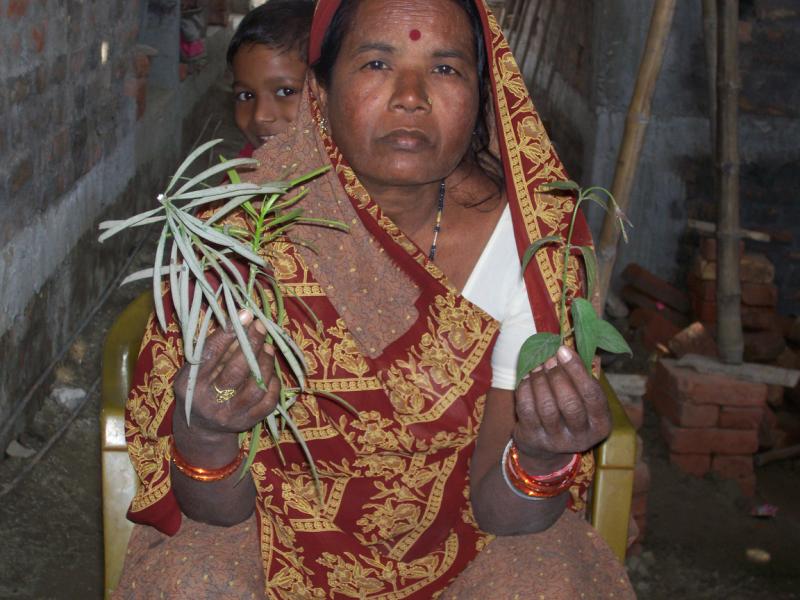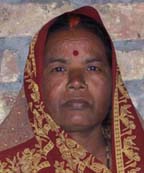Herbal Preparation for Control of Sucking Pests in Crops
.
The persistent problem and the solution
The attacks by white flies have been a major problem for the farmers. The problem of white flies can be found in almost all the agricultural regions of India and the world. In cases of unfavorable conditions, their life cycles can take as long as a year or so. But regardless of the time it takes them to develop into adults, damage is imminent to any host plant on which they reside. Profoundly infested trees become weak and their yield decreases. The host range of the whitefly spreads over 200 plant species mostly in Crucifereae, Fabaceae, Malvaceae and Solanaceae families of. Whitefly is a dangerous pest of cotton, tomato, chilli, citrus, tobacco, alfalfa and other crop plants largely grown in India. But apart from these, the flies also attack a few ornamental plants and other tree species of economic importance.
Many years ago, Janaki Devi cultivated mainly vegetables that got affected by insect pests, which resulted in reduced production. Being aware of the toxic nature of the fruit of Kanail (Thevetia peruviana (Pers.) K. Schum.) and the properties of another local herb, she decided to try the combination of both the plants to control the same.
Her initial attempts yielded good results, which prompted her to use the medication for the control of whitefly also in her crop field. After several experimentations, she finalized a dose of 500g leaves of Kanail and 500g leaves and fruits of the local herb. This combination is soaked or boiled in 1 litre of fresh water (not in cold water) for 1 katha (0.0067 hectare) field and filtered. This formulation is then sprayed twice a day at an interval of 15 days. Some times the spray may be done earlier also depending upon the intensity of the disease. This formulation can also be stored under cool conditions in aluminum or any other vessel.
Initially, she used fresh leaves while preparing the formulation but after continuous experimentation, found that the formulation developed using old leaves was more effective. Whenever the crop is found to be affected by the white fly, this formulation can be sprayed irrespective of the fact whether fields have been irrigated or not.
She has been using this formulation for the past five years or so on lady’s finger, brinjal, bitter guard, pumpkin, lentil, chilly, etc. There has never been any side effect to any crop or any effect on animal or bird. She claims that with a little input in terms of formulation application, the output generated is much greater. Knowing the use of sulfur in fungicides and agrichemicals, she also suggests that if the powder of dried leaves of both the plants is mixed with sulfur, the resultant pesticide may become more effective. She has only suggested this and not tried it herself.
One of the ingredients of the formulation (Thevetia peruviana) is well know for its insecticidal activity. The other local herb that has been used is not reported to have a similar property, which makes the formulation unique for controlling white fly. Considering this, a patent was filed in the innovator’s name (1699/KOL/2008).
Laboratory trials, conducted by Sadbhav SRISTI Sanshodhan Laboratory, Ahmedabad, have demonstrated that the formulation induced significant mortality within a short time application in nymphs. In addition, it appeared to be particularly effective against late instars and at the pupa stage. The preliminary trials also demonstrated that it could significantly reduce pest infestations over an extended period of time and that it performed better than other available products. Repellence increased with the increase in concentration of the formulation.
It was estimated in the laboratory that for the stock solution, 10 litre of water, 2 kg each of the plant material is required. One litre of the filtrate is diluted with 5 litre of water and sprayed over the crop. One spray should be done in the morning and another spray after 5 days interval depending on the infestation of insect-pests. The complete control of white fly can thus be achieved within a week of spraying.
Some other farmers, who were told about this formulation by Janaki Devi, also confirm its efficacy in controlling the white flies. For developing this formulation, Janaki Devi received an Abhinandan Patra from SRISTI during the 22nd Shodhyatra in Champaran, Bihar in January 2009.
Fifty-seven years old Janaki devi, a house wife, using two local herbs, has developed a herbal formulation to control white flies in different crops.
Bettiah, where Janaki devi lives with her family, is the headquarter of West Champaran district of Bihar, near Indo-Nepal border, 225 km from Patna. It is well connected by roads and railways to all major cities of the region. As the region falls in the Indo Gangetic plains, the soil is highly fertile and availability of water for irrigation is aplenty. Farmers of the area grow rice, wheat, sugarcane and maintain some livestock.
Janaki Devi stays with her husband, Parshuram Das, three sons and a daughter in a small brick house. Her husband, who is educated upto matric, is a retired mechanical supervisor of the Irrigation Department in Bettiah. Her daughter and the eldest son, who is doing a degree in Ayurveda, are married. The youngest son is studying while the one elder to him is working as a driver in the Irrigation Department.
Janaki devi is a housewife and is educated upto class four. Apart from possessing skills in managing the household, she holds good knowledge of herbal medicines also. A keen observer and an avid learner since childhood, she used to accompany her father to their agriculture field everyday and helped him in minor chores. Being a curious child, she used to interact with her grand father and elder brothers also. She has been much interested in the use of herbs for curing ailments and making agricultural products. Though she did not practice much agriculture herself but the tremendous knowledge, she gained while interacting with others, is evident in the confidence with which she speaks








